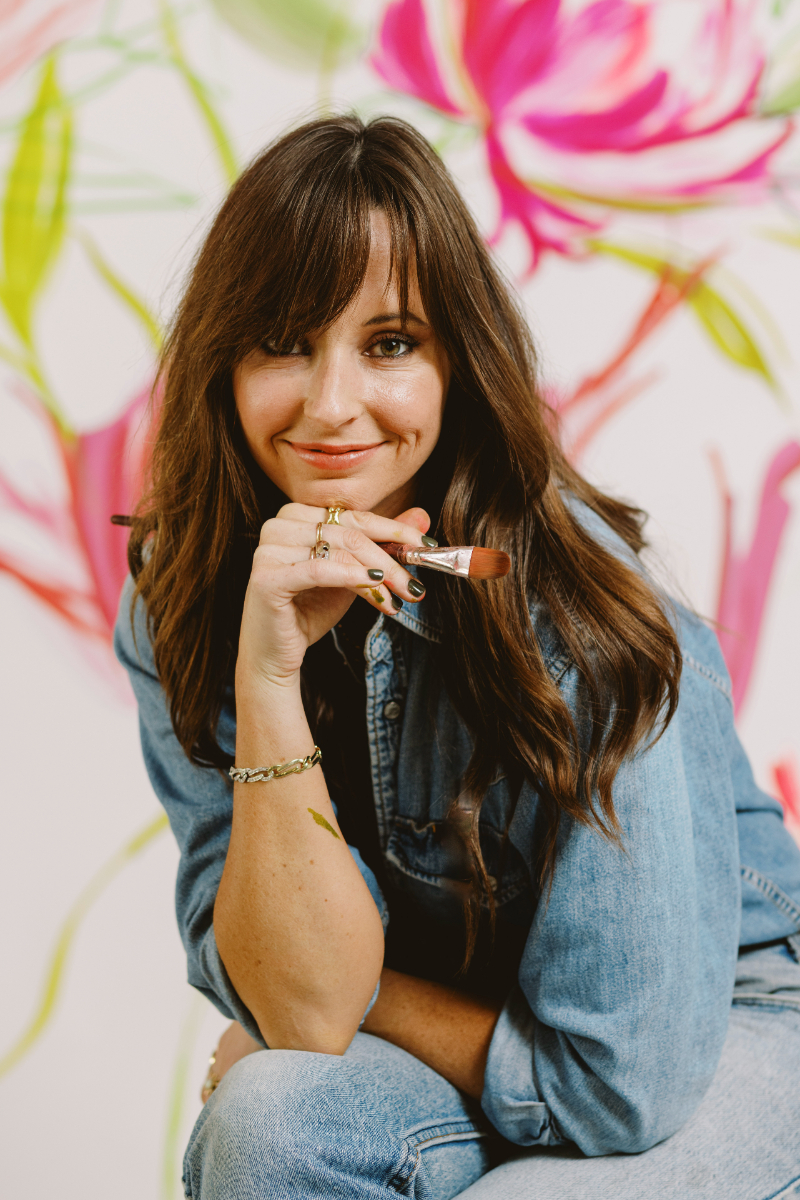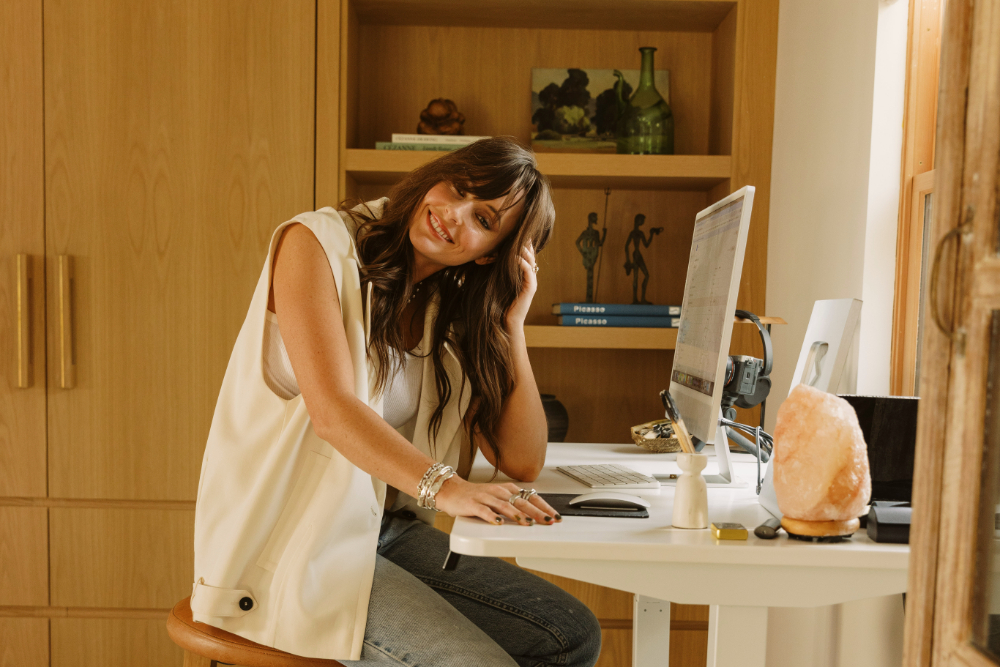Whether you think of yourself as a teacher or not, YouTube is an amazing marketing tool for artists. Have you ever considered starting a YouTube channel? Every single business owner should have at least ONE platform (YouTube, Podcast, Blog, etc.) where they consistently post content to generate organic search traffic. Sure, Instagram and TikTok are sexy, but they are NOT search engines. Therefore, they aren’t the most optimal for attracting new users and potential customers to your brand and offerings. Sure, there are LOTS of artists on YouTube these days, but there’s WAY more on Instagram and Etsy. When you’re able to find your niche and your circle of people who regularly click and watch your videos, there’s really no better way to organically grow your audience and drive profits.
So, if you’re convinced about starting that channel now, below is a checklist and list of tips that my video guy, YouTube expert and husband John put together for you!
P.S. If you’re the type to skip through blog posts and just get to the part where we tell you what equipment you need, I have every tool we use saved HERE!
Checklist and Tips for Starting a YouTube Channel
Have a Purpose
Before launching ANYTHING, it’s incredibly important to have direction. How do you get direction? Analyzing and writing down your purpose for your channel, blog, business, you name it. And get specific! Maybe you’re a painter and want to provide tutorials. What are your goals with these tutorials? What’s the subject matter and who will you be teaching? What’s the vibe of the tutorials? Peaceful and relaxing or upbeat and fun?
The more specific you get, the more focused your channel will be — when people find you, they’ll know exactly what to expect!
What Makes a Good YouTuber?
If you do any ounce of research around YouTube, it’s not hard to find the all-stars or certain channels that really stand out within a specific niche. What makes these YouTubers stand out?
Talent. In your niche/industry/topic, do you have talent or a specific edge you can bring? You don’t need to be the best, but you should have something of value to offer and it can be as simple as being a left-handed painter (not as common) or you love baking and incorporate food into your painting tutorials a lot.
Time. Channels that are performing well and get good views and consistently attract new followers are consistent with posting. Do you have the time to put out consistent videos? I would recommend a minimum of 2-4 videos per month.
Passion. This one is easy to sniff out. Do you love what you’re doing in your videos? You should, because why would you even do something you don’t love. People can reeeally tell when you’re not into it. Along with that, you’ll be more relatable and make more of an impact on your people!
Personality. You don’t have to be the most charismatic person, but it helps! Be yourself and be engaging. Even if you feel like you’re boring or your quirks are too weird, viewers out there just want to watch someone they can relate to. Showing personality really helps!
Get Your Channel.
Once you have your idea and purpose nailed down and your unique edge, it’s time to actually set up your channel! First, you need to have a Google account and then you can set it up.
When naming your channel, think about how memorable and easy to type in the search bar it will be. If people forget to subscribe to your channel but they want to search for you on YouTube, it’s important that they actually remember your channel name easily! Your own personal name works or your business name. Make it stand out and attractive to your ideal audience!
Once you’ve got the name and the channel, don’t forget to customize your channel to YOUR vibe. Banner, profile pictures, watermark, etc. with your colors, images and more. You also want to make sure that all of the copy on your YouTube page and in your videos is authentic. Copying someone else’s vibe and video ideas is super uncool.
Research What Works in Your Niche.
This is one of the most important pieces to any business on any platform, RESEARCH! And I don’t mean research to copy what’s out there, but rather to have a pulse on what’s working and not working. Go to channels that are similar to the one you want to have and look at their videos. How often do they post? What are the topics and categories? Click on their ‘most popular’ videos and look for common themes. Why are those videos taking off and getting lots of views? How long are they? Take notice of their titles, thumbnails and video length.
Related: Why Niching Down Your Art Business Is So Important
Plan Your Videos for Success.
Before you even start recording your videos, plan out your titles and thumbnails! Captivating titles that use KEYWORDS that your audience would type into the search bar to find that particular video is HUGE. You can’t have successful videos if they aren’t discoverable! Once they’ve pulled your video up in their search, is your thumbnail captivating and going to make them want to click? Consider working in questions that need to be answered, shock and awe, “You’ll NEVER believe this!!” type of language. It might seem dramatic, but there’s SO much noise and competition out there, this is an important step in grabbing the attention of the searcher.
PRO TIP: Search for videos in the YouTube search that relates to your channel. When the search bar starts to autofill (before you hit enter on the search), that is showing you the most popular searches from other people. This is a great place to get video ideas. Don’t forget to work those keyword phrases into your titles and video description!
Get the Right Equipment that Works for You!
Be realistic with your film skill level and financial situation. There are MANY highly successful channels out there that have horrible video quality. Do I recommend this? No. Having good quality video and audio is definitely important, but find a camera (external lenses if needed), separate audio recorder and mic, and lighting that works for you. It could be as simple as an iPhone with a ring light, but I would definitely recommend a separate audio recorder.
In addition to those main tools, consider memory cards, external hard drives to work off of (if you put all your files directly onto your computer, that will fill up fast!), and tripod.
Don’t forget editing software! You can use the software on your computer, but that will greatly limit what you will be able to do. Consider getting and learning an app like Adobe Premiere Pro. One crash course tutorial on YouTube is all it takes to learn the basics!
Here’s the full list of all the camera, audio, tripod gear we use for filming!
CONSISTENTLY Make Engaging and Quality Videos
You absolutely do not need ultra high quality 4k studio videos with the expensive gear we have, but the nicer you can get the video/audio, the better. Especially if what you’re showing is step-by-step tutorials, you want the lighting and video to make what you're painting visible and not frustrating to watch. Learn your camera and get your settings figured out. Hint, hint: John learned EVERYTHING he knows now about video stuff on YouTube itself!!
Audio is super important, too. Make sure your audio is high quality – if the sound is hard to listen to, that will repel viewers.
Along with that, you want to edit so that your videos don’t drag on. Keep them enticing because all YouTube cares about is that your videos keep people on YouTube. That means watch time is everything! Once people have clicked on your video, they need to stay on your video. If they click and stay, the viral potential increases greatly! If they click and leave, that video will enter the YouTube graveyard.
Have Fun and Be Patient.
At the end of the day, it’s a YouTube channel, have fun with it! If you are motivated purely based on making money, it will likely be a difficult road. Regarding revenue, don’t expect to make any kind of serious money until you’ve put in serious work for a year or two (at least).
YouTube revenue can come from ad placements in your videos, but the real income earner here comes through: 1) affiliate links to supplies you use and 2) using it as a content tool for talking about your own offerings like online courses, prints, etc. YouTube is an amazing place to build credibility in your audience and provide them with tons of FREE, valuable stuff. If your viewers love your free stuff, then they’re going to love your paid stuff even more— that’s the goal here. If you have fun, stay passionate and patient, you can have a successful YouTube channel!















+ show Comments
- Hide Comments
add a comment